صمام ثنائي باعث للضوء
| Light-emitting diode | |
|---|---|
 ثلاثة أنواع من الليزر أحمر وأزرق وأخضر ، وكل منهم مقاس 5 مليمتر | |
| النوع | Passive, optoelectronic |
| مبدأ العمل | Electroluminescence |
| المخترع | Nick Holonyak Jr. (1962) |
| الرمز الإلكتروني | |
| ترتيب الدبابيس | Anode and Cathode |
مصباح ثنائي باعث للضوء أو ديود باعث للضوء light-emitting diode (LED) هو مصدر ضوئي يبعث الضوء حينما يمر به تيار كهربائي . يرجع تطويره إلى الستينات من القرن العشرين عندم أكتشاف أنصاف الموصلات . في البدأ كان يبعث ضوءا واحدا ضعيفا ، لكن مع الوقت أمكن تطويره لبعث الثلاثة ألوان المستخدمة كثيرا في التكنولوجيا اليومية ، الأحمر والأزرق والأصفر . وكثيرا ما يـُستعمل في أللوحات الكبيرة المنيرة وغيرها .وأصبح لها طاقة كبيرة على إصدار ضوءا ناصعا ً .
. . . . . . . . . . . . . . . . . . . . . . . . . . . . . . . . . . . . . . . . . . . . . . . . . . . . . . . . . . . . . . . . . . . . . . . . . . . . . . . . . . . . . . . . . . . . . . . . . . . . . . . . . . . . . . . . . . . . . . . . . . . . . . . . . . . . . . . . . . . . . . . . . . . . . . . . . . . . . . . . . . . . . . . .
ابتكار الثنائي
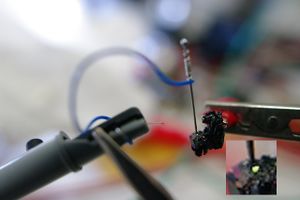
اخترعه الياباني شوجي ناكامورا وبدأ ابتكاره على إثر اختراع أنصاف الموصلات التي ازداد استعمالها في النصف الثاني من القرن الماضي في الحاسوب .ففى الثنائي الضوئي بتأثير التيار الكهربائي تقفز إلكترونات الذرة من حالة كمومية عالية الطاقة إلى حالة كمومية منخفضة، فيصدر الإلكترون فارق الطاقة بين الحالتين على هيئة فوتون أي شعاع ضوء ذو تردد محدد وبالتالي له طول موجة محددة . وباختيار مادة الثنائي يمكن الحصول على لون الضوء الصادر منه وهذا الاختيار يتعلق باختيار المدارين الذريين الذي يقفز من أحدهما الإلكترون إلى المدار الآخر المنخفض . فهذا الفارق يحدد طول موجة الشعاع الذي يطلقة الإلكترون عند قفزته وبالتالى لون الشعاع .
الثنائي باعث للضوء -واختصاره بالأنجليزية LED - له ميزات كثيره يتفوق بها عن الوسائل المعتادة للإضاءة. فهو يستهلك قليلا من الطاقة الكهربائية ويمكن تشغيله ببطاريات صغيرة ، وعمره طويل ويتحمل الصدمات وصغير الحجم فهو لايزيد عن 5 مليمتر في مقاييسه . إلا أنه مايزال باهظ الثمن نسبيا ، كما أنه يحتاج إلى مصدر كهربائي ذو تيار ثابت ، وأنظمة لتشتيت الحرارة المنبعثة منه .
كل تلك الميزات أفسحت المجال لاستخدام الديود باعث الضوء في مجالات لا تستطيع وسائل الإضاءة التقليدية القيام بها ، وعلى الأخص تلك التطبيقات القائمة على مصادر صغيرة للطاقة . و على الرغم من ارتفاع ثمنه نسبيا فتـُجرى البحوث في تطويره للقيام بوظائف خاصة عدا مجرد الإضاءة ، و مايزال طريق تطويره مفتوحا ً.
الاستخدام العملي
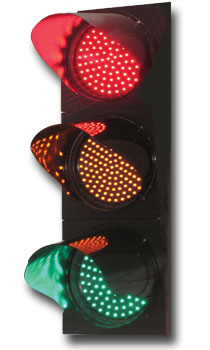
The first commercial LEDs were commonly used as replacements for incandescent indicators, and in seven-segment displays,[1]
مواصلة التطوير
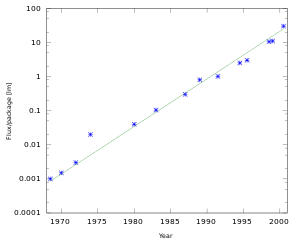
التكنولوجيا
الفيزياء
طول العمر والفشل
الألوان والمواد
Conventional LEDs are made from a variety of inorganic semiconductor materials, the following table shows the available colors with wavelength range, voltage drop and material:
| Color | طول الموجة (nm) | Voltage (V) | مادة شبه الموصل | |
|---|---|---|---|---|
| Infrared | λ > 760 | ΔV < 1.9 | Gallium arsenide (GaAs) Aluminium gallium arsenide (AlGaAs) | |
| Red | 610 < λ < 760 | 1.63 < ΔV < 2.03 | Aluminium gallium arsenide (AlGaAs) Gallium arsenide phosphide (GaAsP) Aluminium gallium indium phosphide (AlGaInP) Gallium(III) phosphide (GaP) | |
| Orange | 590 < λ < 610 | 2.03 < ΔV < 2.10 | Gallium arsenide phosphide (GaAsP) Aluminium gallium indium phosphide (AlGaInP) Gallium(III) phosphide (GaP) | |
| Yellow | 570 < λ < 590 | 2.10 < ΔV < 2.18 | Gallium arsenide phosphide (GaAsP) Aluminium gallium indium phosphide (AlGaInP) Gallium(III) phosphide (GaP) | |
| Green | 500 < λ < 570 | 1.9[2] < ΔV < 4.0 | Indium gallium nitride (InGaN) / Gallium(III) nitride (GaN) Gallium(III) phosphide (GaP) Aluminium gallium indium phosphide (AlGaInP) Aluminium gallium phosphide (AlGaP) | |
| Blue | 450 < λ < 500 | 2.48 < ΔV < 3.7 | Zinc selenide (ZnSe) Indium gallium nitride (InGaN) Silicon carbide (SiC) as substrate Silicon (Si) as substrate — (under development) | |
| Violet | 400 < λ < 450 | 2.76 < ΔV < 4.0 | Indium gallium nitride (InGaN) | |
| Purple | multiple types | 2.48 < ΔV < 3.7 | Dual blue/red LEDs, blue with red phosphor, or white with purple plastic | |
| Ultraviolet | λ < 400 | 3.1 < ΔV < 4.4 | diamond (235 nm)[3] Boron nitride (215 nm)[4][5] Aluminium nitride (AlN) (210 nm)[6] Aluminium gallium nitride (AlGaN) Aluminium gallium indium nitride (AlGaInN) — (down to 210 nm)[7] | |
| White | Broad spectrum | ΔV = 3.5 | Blue/UV diode with yellow phosphor |
Ultraviolet and blue LEDs

الضوء الأبيض
أنظمة RGB
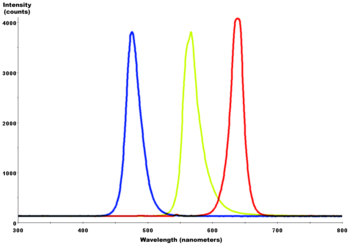
Phosphor based LEDs
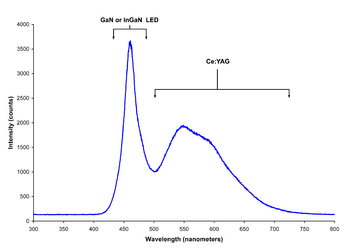
. . . . . . . . . . . . . . . . . . . . . . . . . . . . . . . . . . . . . . . . . . . . . . . . . . . . . . . . . . . . . . . . . . . . . . . . . . . . . . . . . . . . . . . . . . . . . . . . . . . . . . . . . . . . . . . . . . . . . . . . . . . . . . . . . . . . . . . . . . . . . . . . . . . . . . . . . . . . . . . . . . . . . . . .
الأنواع
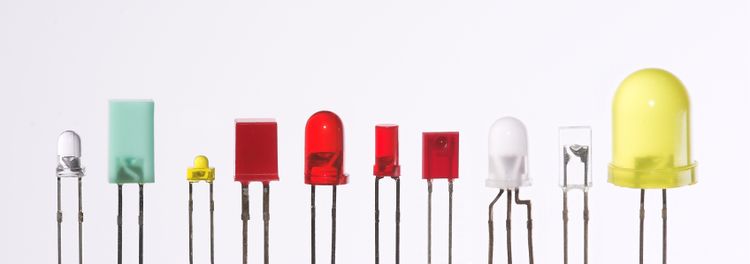
Miniature LEDs
High power LEDs
SuperFlux/Piranha LEDs
تنويعات لاستخدامات متخصصة
الاستخدامات


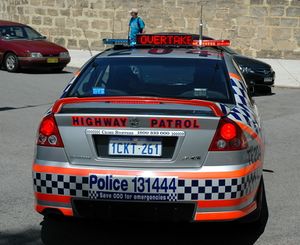
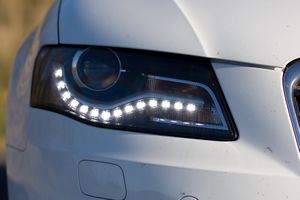
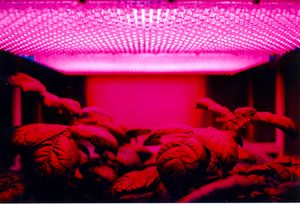
دائرة الثنائي باعث الضوء
في الإلكترونيات ، تكون الدائرة الأساسية هي دائرة ليد (LED) التي تستخدم لإضاءة الصمام الثنائي . وهو يتألف من عنصرين لهما وصلة في سلسلة :
مع جهد المصدر ، ومفتاح لفتح الدائرة (الثنائي يطفأ) وإغلاق الدائرة (الثنائي يضيء). ويمكن توصيله بجهاز تحكم فيضيء وينطفئ بصورة دورية.
اختصار الكلمة
من اللفظ light-emitting diode أي : صمام ثنائي يضييء
انظر أيضاً
- Display examples
- Laser diode
- LED circuit
- LEDs as light sensors
- Nixie tube
- Solid state lighting (SSL)
- إلكترونيات
- شاشات الإظهار
- صمام ثنائي
. . . . . . . . . . . . . . . . . . . . . . . . . . . . . . . . . . . . . . . . . . . . . . . . . . . . . . . . . . . . . . . . . . . . . . . . . . . . . . . . . . . . . . . . . . . . . . . . . . . . . . . . . . . . . . . . . . . . . . . . . . . . . . . . . . . . . . . . . . . . . . . . . . . . . . . . . . . . . . . . . . . . . . . .
المصادر
- المذكورة
- ^ "LEDs cast Monsanto in Unfamiliar Role".
- ^ OSRAM: green LED
- ^ Koizumi, S. (2001). "Ultraviolet Emission from a Diamond pn Junction". Science. 292 (5523): 1899. doi:10.1126/science.1060258. PMID 11397942.
{{cite journal}}:|first2=missing|last2=(help);|first3=missing|last3=(help);|first4=missing|last4=(help) - ^ Kubota, Y. (2007). "Deep Ultraviolet Light-Emitting Hexagonal Boron Nitride Synthesized at Atmospheric Pressure". Science. 317 (5840): 932. doi:10.1126/science.1144216. PMID 17702939.
{{cite journal}}:|first2=missing|last2=(help);|first3=missing|last3=(help);|first4=missing|last4=(help) - ^ Watanabe, Kenji (2004). "Direct-bandgap properties and evidence for ultraviolet lasing of hexagonal boron nitride single crystal". Nature Materials. 3 (6): 404. doi:10.1038/nmat1134. PMID 15156198.
{{cite journal}}:|first2=missing|last2=(help);|first3=missing|last3=(help) - ^ Taniyasu, Yoshitaka (2006). "An aluminium nitride light-emitting diode with a wavelength of 210 nanometres". Nature. 441 (7091): 325. doi:10.1038/nature04760. PMID 16710416.
{{cite journal}}:|first2=missing|last2=(help);|first3=missing|last3=(help) - ^ "LEDs move into the ultraviolet". physicsworld.com. May 17, 2006. Retrieved 2007-08-13.
- العامة
- Shuji Nakamura, Gerhard Fasol, Stephen J Pearton The Blue Laser Diode: The Complete Story, Springer Verlag, 2nd Edition (October 2, 2000)
- Mills, Evan (2005). "The Specter of Fuel-Based Lighting". Science. 308 (5726): 1263–1264. doi:10.1126/science.1113090. PMID 15919979.
- Moreno, I., "Spatial distribution of LED radiation," in The International Optical Design Conference, Proc. SPIE vol. 6342, 634216:1-7 (2006).
- Salisbury, David F. (October 20, 2005). "Quantum dots that produce white light could be the light bulb's successor". Exploration—The Online Research Journal of Vanderbilt University. (More details regarding the use of quantum dots as a phosphor for white LEDs.)
وصلات خارجية
- معلومات حول دائرة ليد
- Dendrimers in the spotlight - an Instant Insight examining the use of dendrimers in organic light-emitting diodes from the Royal Society of Chemistry
- Photonics Sources Group, Tyndall National Institute GaN and other photonics research at the Tyndall National Institute, Ireland.
- LEDWire Canadian LED industry news wire service.
- MAKE Presents: The LED - A movie about the origins of the LED and how to make your own from carborundum!
- Rensselaer Electrical Engineering Department LED information arranged in textbook form, aimed at introductory to advanced audience
- Uncertainty evaluation for measurement of LED colour










